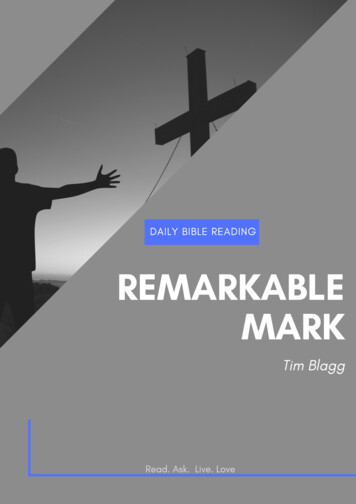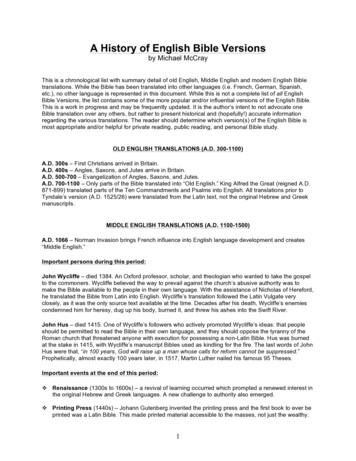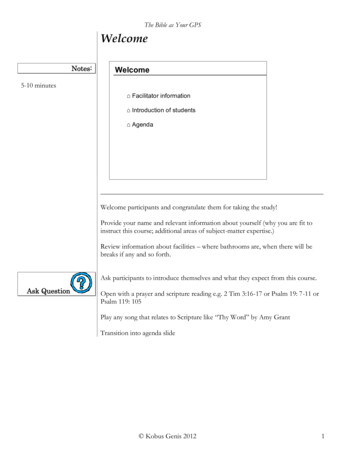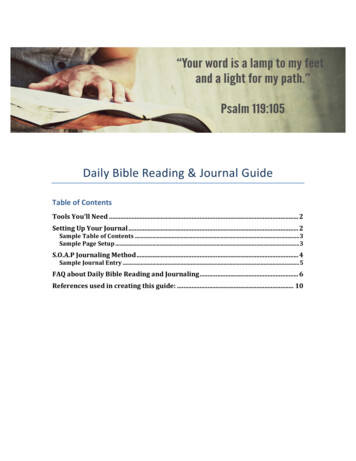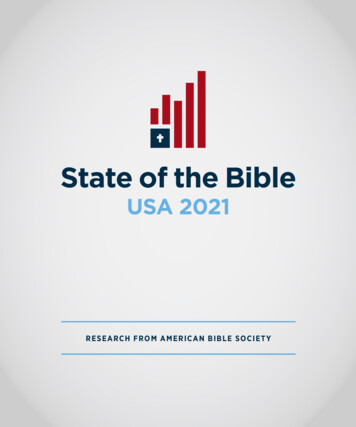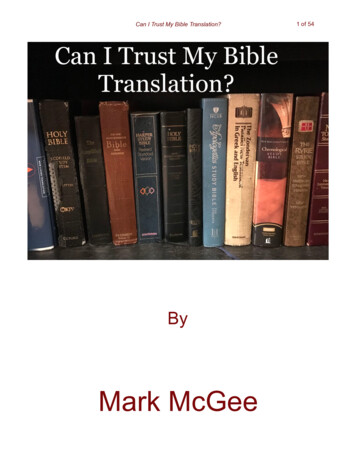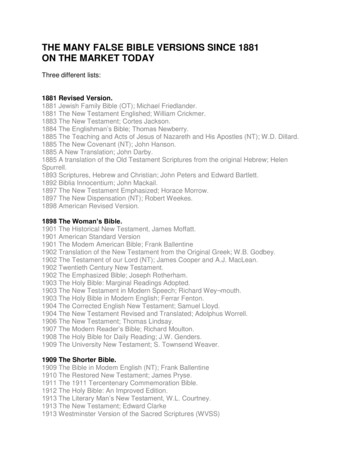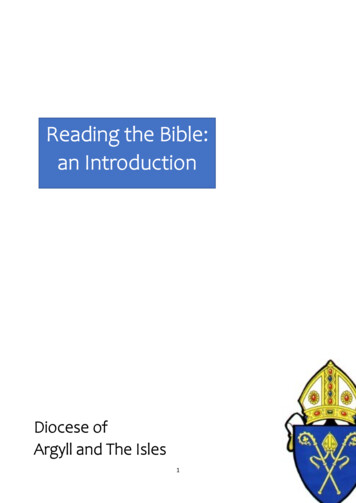
Transcription
Reading the Bible:an IntroductionDiocese ofArgyll and The Isles1
This study booklet began life as a lay training event (on Zoom) inMay 2020, entitled Reading Scripture. We produced a booklet(Reading Scripture: a study course for individuals and groups)which covers the material of that event in full, with suggestions forindividual and group use, and a list of further reading. The presentbooklet is a shorter, and rather more introductory, guide forpeople who want to know a bit more about the Bible and how toread itThis material can be studied by individuals or by groups.For groups, we suggest that participants should read the materialin advance, and the group can then meet (in whatever way ispossible!) and discuss the material and their reflections on thequestions embedded in the material. It could be broken into fourshort sessions:1) pp 5-11 on the contents and structure of the Bible2) pp 12-15: The Big Picture3) pp 16-20 Reading the Bible – different types of writing4) pp 21-23 Ways of reading the Bible.Or 1 & 2 and 3 & 4 could be combined to make 2 sessions.We have provided worship suggestions for the sessions. Thisincludes a lectio divina, one way of reading Scripture.You will find it useful to have Bibles available.This material was authored by Ros and Chris Brett for the Diocese of Argylland the Isles.Bible quotations are generally from the New Revised Standard AnglicizedEdition.2
Opening WorshipYou may like to light a candlePrayerLoving God, we come into the awareness of your presence. Butyou have never been absent from us. Open our eyes to see you,and open our hearts to listen to your words of life.AmenLectio divinaChoose one of the following passages. Have it read aloud (ifpossible, by 3 different people).Genesis 32:22-30Psalm 8John 15:1-11Philippians 2:5-11Hear it a 1st time (lectio).Listen. What particularly strikes you?Hear it a 2nd time (meditatio).Listen again. Dwell on, ‘chew over’ what has struck you.Hear it a 3rd time (oratio).Pray silently as you listen again.A silence is kept (contemplatio) – simply ‘be’ in the presence ofGod.3
After the silence members of the group may speak out a word orphrase from the passage which has struck them and meantsomething to them (no discussion).Say togetherHoly and loving God, we thank you forYour Word, which was from the beginningYour Word, which spoke this world into beingYour Word, revealed in the child of BethlehemYour word, revealed through prophetsYour word, written for our instructionYour word, giving speech for our praiseThrough the written word and the spoken wordMay we behold the living Word,even your Son our Lord, Jesus Christ. AmenClosing WorshipGod of all trust,may we who confess your faith prove it in our lives, withabundant joy, outrageous hope and dependence on nothing butyour word alone,through Jesus Christ.AmenJanet MorleyThe Grace4
Reading the BibleWhat is the Bible? The Bible is a collection of books, yet oftenregarded (and perhaps with good reason) as one book. It containsthe sacred writings of Jews and Christians. It’s also what we readin church (and for that matter in the synagogue) in smallishsections for the day. It’s the basis for most sermons. For some, it isthe word of God, which we read to learn about God and how tolive our lives. For others, it is simply great literature (especially inthe 17th century English of the King James Version). For yet others,it is somewhere in between those two.This booklet is aimed at people – principally members of churchcongregations – who want to know a bit more about the Bible andhow to read it and understand it. (It does not specifically considerhow to read the Bible aloud in public worship.) For that reason, itcontains questions for thought or discussion, and suggestions forscripture reading and prayer.This study guide assumes that you read or use the Bible in someway already. You might like to spend some time considering thefollowing questions:What does the Bible mean to you?If you were trying to explain the Bible to someone of anotherfaith, or who hadn’t encountered the Bible before, how wouldyou describe it?5
This is the contents page of a (relatively straightforward) edition ofthe Christian Bible:It’s divided into the Old Testament (which has 39 sections orbooks) and the New Testament (27 sections or books).6
The New TestamentLet’s begin with the New Testament – you may know this betterthan the Old! Together with the Old Testament (as we call it – we’llcome to that later), it forms the scripture, the sacred writings ofthe Christian church. It contains the story of the birth, life, deathand resurrection of Jesus, and the story of the early church, plusletters of teaching and advice to churches and individuals in theearly period of the church, and finally an apocalypse.1Box 1: Organisation of the New TestamentGospels – life, work, death and resurrection of Jesus(4 books)Acts of the Apostles – narrative of the early churchbut Luke & Acts form a 2 part series(1 book)Letters (Epistles)Attributed to Paulto churchesto individuals (the ‘pastoral’ letters)Hebrews (author unknown)Attributed to other writers(James, Peter, John, Jude)(9 books)(4 books)(1 book)Revelation (apocalypse)(1 book)1(7 books)Apocalyptic writing is a literary form we find in both the Old and the NewTestaments. ‘Apocalypse’ means ‘revelation’, and the writing is usually about theend times, with imagery which is often rather surreal and fantastic. It is not meantto be taken as literal prophecy.7
The New Testament was written in koine (common) Greek, a formof Greek which was the common language of the area at the time.Jesus probably spoke some Greek, in order to do business andspeak to foreigners, but it is almost certain that he and his discipleshad Aramaic as their first language. The books of the NewTestament were written over a period from around 20 years afterJesus’ death (c. 50 CE2) to perhaps 110 CE. However, the stories ofJesus will have been circulating in oral form before the gospelswere written down.We possess no originals of the New Testament writings. They werecopied and recopied by scribes for distribution and use. There arenearly 6,000 manuscripts of New Testament writings, dating fromthe second century CE up to the invention of the printing press.(Compare that with the c.1,500 copies of Homer’s Iliad.) Thus wecan have good confidence in the general accuracy of what hascome down to us. Because of the potential errors in copying, theearlier the manuscript the more reliable it is. Some of the earliestare mere fragments, some contain several books. If you see afootnote in your Bible that says something like ‘other ancientauthorities read .’, it means there are significant differences atthat point between manuscripts. The translators have judgedwhich is likely to be more authentic and original.Have you ever read the New Testament through frombeginning to end? Or an individual book at one sitting?Which parts of the New Testament do you read most? Why?This booklet uses the convention of dating using Before the Common Era (BCE) andCommon Era (CE) rather than the traditional BC and AD to which they areequivalent.28
The Old TestamentWhat we call the Old Testament (‘testament’ in this context meanscovenant, a solemn agreement) is the collection of the Scripturesof the Jewish people. Jews call it the TaNaKh which is an acronymfor the Hebrew words for the three sections of the JewishScrptures – the Law (you may know the Hebrew word for this,Torah), the Prophets and the Writings. Christians call it the ‘OldTestament’ because for Christians the Bible is the story of the(‘old’) covenant between God and Israel which is fulfilled (‘the newcovenant’) in Jesus.Many scholars and others prefer to refer to the Old Testament asthe Hebrew Scriptures. They are the Scriptures of the Jewish faith.It is important to remember that they were also the Scriptures ofJesus and his earliest followers. This booklet will use ‘OldTestament’ for convenience.The Old Testament was mainly written in Hebrew, a Semiticlanguage in the same broad language group as Arabic. Some partsof the Old Testament are in Aramaic, a closely related languagewhich the Jewish people began to speak when they were in exilein Babylonia.Do you read the Old Testament? Why/why not?The earliest Christians only had the Scriptures we now call theOld Testament, which they knew and quoted. Do you think it isimportant for Christians today to read and know somethingabout the Old Testament?9
The history of the Hebrew Bible is longer and less clear than thatof the New Testament. 2 Kings recounts how Josiah (who reignedin the second half of the 7th century BCE) found part of the Law;also there are references in 2 Kings to the ‘annals’ of the kings ofIsrael and Judah. Thus some of the law, story and history may haveexisted in written form by then – though after a very long periodof oral transmission. It is thought that most of the written HebrewScriptures were set down in the period of exile in the 6th centuryBCE and in the Second Temple period after the return from exile.A Greek translation (the Septuagint) was made, starting in around300 BCE with the Torah - Genesis to Deuteronomy.The Old Testament contains the story of God’s ancient peopleIsrael, the laws of Israel, psalms and other poetry, wisdomwritings, and prophecy.The ApocryphaThe Septuagint contains some books which were not included inthe fixed text of the Hebrew Scriptures, and they are notauthoritative for Jews. Some Christian Bibles include them, butChristians have always regarded them as less authoritative thanthe present Old and New Testaments – or not authoritative at all.The SEC includes them in the Lectionary, but always provides analternative reading for main services.The ‘other’ gospels?You may be aware of ‘gospels’ and some other writings which didnot make it into the New Testament. On the whole, they are laterthan the New Testament writings. Some were regarded in the10
early centuries of the church as worth reading, though not publiclyas Scripture; some were regarded as frankly heretical.Chapter and verseIn the case of both Testaments, the chapter and verse format thatwe are now familiar with (and which is handy for finding your wayround!) was added much later for convenience.Box 2: Organisation of the Old TestamentThe Torah (Law) or Pentateuch (Five Books/scrolls) – as well aslaw, a lot of narrativeGenesis – Deuteronomy(5 books)HistoryJoshua – Esther(12 books)Wisdom literatureJob – Song of Songs/Song of Solomon(5 books)Prophets – mostly prophecy, but includes some narrative.Isaiah – Malachi(17 books)But note For Jews, the Scriptures are divided into:Torah or Law:Prophets:Writings:Genesis – DeuteronomyFormer Prophets – Joshua, Judges, Samuel, KingsLatter Prophets – Isaiah, Jeremiah, EzekielTwelve Minor Prophets (Hosea – Malachi)The remainder of the books11
The Big PictureA book of books. Many different forms of literature (we’ll look atthat later on). How are we going to make sense of it? Can we? Ordo we just pick parts out and take what we can from thosepassages?This section assumes that understanding the big picture helps usread the bits. That in turn is based on a conviction that the story ofGod’s dealings with his people is a coherent one.Here’s a timeline .?1800 BC?1300AbrahamJacobThe great inesNehemiah John the Baptist usEzraApostlesAssyriaBabylon124 BC 30 ADPersiaRomeGreece?
The vertical axis could be labelled ‘The state of God’s people’.Even this simplified picture has many ups and downs.The biblical story begins with the world as God created it humankind in the form of Adam and Eve in a good relationshipwith God and the created world. Then as a consequence of the Fall- God’s people refusing to obey him – humankind’s relationshipwith God and creation is spoiled. The people increase in numberand disobedience. The story of the Flood describes a new startwith a covenant with Noah, but the story of the tower of Babelindicates that people did not remain obedient.In Abraham, God chooses a family through whom he will bless theworld. They are a mixed bunch, but they remain faithful on thewhole and they are blessed with material wealth and relativepeace. Then a famine forces them to migrate to Egypt, where theyare made welcome. They continue to prosper for a while, but alater administration fears them because they are numerous andpotentially powerful, so enslaves them. God commissions Mosesto lead the people out of Egypt – the Egyptians are finallypersuaded by plagues sent on them by God to let the people go.This Exodus remains a key event in the Jewish story. The peopleget to the Promised Land of Canaan after many ups and downs anda long period wandering in the desert. God gives them a set of lawsto live by.In Canaan, the people go through cycles of: faithfulness – fallingaway to worship local gods – defeat by local enemies – rescue bya ‘judge’ God gives to lead them. Eventually, the people ask for aking. The prophet Samuel anoints first Saul, then David, as king.The kingdom reaches a high point under David’s son Solomon,who builds the Temple.13
The harsh rule of Solomon’s son Rehoboam splits the kingdom.Ten tribes form the Northern Kingdom, Israel. They are idolatrousfrom the start, and the kings are bad rulers. Ultimately, Assyriadestroys the kingdom in 722 BCE and deports some of the peopleto exile in Assyria (and settles some people of other nations inIsrael). The other two tribes form the Southern Kingdom, Judahwhich remains loyal to Rehoboam. Judah has some good kings, butthe majority are bad rulers, and Judah also becomes idolatrous anddisobedient. Judah falls to the Babylonians in 586 BCE, the Templeis destroyed and the people exiled to Babylon. In Babylon, theexiles undergo a period of religious reform.When Babylon is defeated by the Persians, Cyrus allows the exilesto return to Jerusalem. Some stay in Babylonia, but some return torebuild Jerusalem in 536 BCE. A new Temple is built. But in theSecond Temple Period, the glorious presence of God is absent, theJews are subject to foreign rulers (apart from independence underthe Maccabees, 164-63 BCE), and prophecy ceases from about 400BCE.Jesus is born around 4 BCE. John the Baptist breaks the propheticsilence around 30 years later, and Jesus proclaims the Kingdom ofGod in a ministry lasting about 3 years. Jesus is tried and crucified,but appears, resurrected, to his disciples before finally ascendingto his Father God.The church is born on the day of Pentecost, and grows andspreads. The story ends with the promise of Jesus’ return, whichwill fully reveal the Kingdom, and the prospect of the future NewHeaven and New Earth.14
The other ‘big picture’ aspect is that there are many key themesrunning through the Bible from Genesis to Revelation. Some ofthese themes are: Word; Kingdom; Temple; Law; Creation/newcreation; Salvation; Spirit .You might like to follow through the example in the box below.WordRead Genesis chapter 1. Note the repetition of ‘God said’. AtGod’s word, creation happened.The proclamations of the Prophets are introduced by ‘The wordof the LORD came to.’ See Jeremiah 1:2, Ezekiel 1:3. Othersreceived promises and instructions when the word of the LORDcame to them. See Genesis 15:1 (Abraham), 1 Samuel 15:10(Samuel), 1 Kings 6:11 (Solomon), 1 Kings 19:9 (Elijah). Sadly,sometimes God was silent – see 1 Samuel 3:1.In John 1:14 ‘The Word became flesh and lived among us.’In Acts 8:4, those disciples who were scattered following thestoning of Stephen ‘went from place to place, proclaiming theWord’.The writer to the Hebrew speaks of the Word of God being‘living and active’ (Hebrews 4:12)Paul tells Timothy that ‘the Word of God is not chained’ (2Timothy 2:9)The letters to the 7 churches in Revelation give the ‘words of.’different descriptions and titles of Jesus. (Revelation 2:1, 2:8,2:12, 2:18, 3:1, 3:7, 3:14)15
Reading the BibleWhy do we read the Bible?Why do you read the Bible? Do you read the Bible, and if so,how?Reading the Bible; why, when and where?There are all kinds of reasons for which and contexts in which weread the Bible. Of course, we read it in public worship, and it isthen often followed by a sermon usually based on one or more ofthe readings. We may read it together in study groups, to see whatit has to say about a specific issue, or focussed on a particularseason of the church’s year, or just to study it in more depth. Manyread the Bible daily on their own, to focus on God and to informtheir private prayers. And some – both people of faith and peopleof no faith - study it in a more academic way.These are all valid ways of reading the Bible, but they requiredifferent approaches. All of them are helped by an understandingof how this book of books works.Different types of writingThe Bible is not a textbook or a rule-book. It is a glorious mixtureof different kinds of writing – story, history, laws, poetry,prophecy, letters and so on. We need to read these different kindsof writing differently. Would you read a love letter and a sciencetextbook in the same way? Or a newspaper and a joke book? Ofcourse not. So it is with the Bible. We have to understand what thedifferent kinds of writing are, so we know how to treat each one.16
The major kinds of writing in the Bible are:Narrative: stories of early humans and the beginnings of God’speople; history; stories which may be historical fiction/moral talesor ; the story of the early church, and of course the gospels, whichwe’ll consider separately.Law: including the Ten Commandments, but also very detailedrules for living and for worship.Poetry: eg Psalms, the Song of Songs, and poetic passageselsewhere.Wisdom literature: advice and reflections on life.Prophecy: Including ‘forth-telling’ – contemporary critique, butalso fore-telling of God’s actions.Letters: in the New Testament, letters of advice to churches andindividuals.(There is a bit more detail on all of these in Appendix 1.)And Gospel. We’ll look at the gospels in more detail.GospelsWhy the gospels? Why four gospels?The gospels were written later than most of the letters. In the earlydays of the spread of the gospel, the good news, of Jesus, the storyof Jesus’ life, ministry, death and resurrection, was told orally bythose who were eye-witnesses of the events and by those who hadheard it directly from those eye-witnesses. It is likely that as timewent on and the preachers were more distanced from the events,the story was written down for accurate preservation of thememories.17
Why four gospels? We do not really know. The author of Luke andActs tells us that he (presumbly, he ) set out to write ‘an orderlyaccount’ for ‘Theophilus’ (a pseudonym? – it means ‘friend ofGod’) so that he would know the truth. The writer of John tells hisreaders that he wrote ‘so you may come to believe ’. Each gospelwriter had a different perspective on Jesus. Whatever the reasonsfor the writing and keeping in the authorised scriptures of fourgospels, we get a richer picture of Jesus from reading four versions.They are not biographies in the modern sense, with everythingdetailed in order from the family background of the person, theirbirth, their education and so on until their death. Rather, thewriters choose and arrange their material to emphasise their mainpoints.Mark, probably written first, is short and racy. He gives no birthstories – after a one-verse introduction he gets straight to John theBaptist. Mark’s gospel also ends very abruptly, with noresurrection appearances. Key themes in Mark are: Jesus as theSon of God; Jesus as a rejected and suffering Messiah; and, thefailure of his disciples to understand. Mark was probably writtenfor Gentiles, non-Jews.Matthew and Luke have a lot of material which is in Mark, butsome additional material which is common to Matthew and Luke.Each also has some unique material.Matthew is the most Jewish of the gospels – there are manyquotations from the Old Testament. Yet there is much criticism ofthe Jewish establishment. There is also an anti-Roman element.Key themes include Jesus as a Moses-like Teacher, and Jesus as18
fulfilment of the Law and the Prophets. Matthew’s birth storiesmajor on Joseph and his role.Luke is the first of a two-part series – the story is continued in Acts.The writer takes pains to locate the events within contemporaryhistory. Luke is probably a Gentile and writes for Gentiles. A keytheme is Jesus’ concern with the poor and the sociallyunacceptable, and with women and non-Jews. His birth stories arelargely written from Mary’s perspective.John is thought to have been written independently of Mark,Matthew and Luke (the ‘synoptic’, seen-together, gospels). Thisgospel is later, more reflective and ‘theological’, and with a stresson Jesus’ divinity. It was probably written for a mixedJewish/Gentile community under internal and external pressure. Ithas a highly theological (and poetic!) prologue, a first main sectionshaped by Jesus’ ‘signs’, a second main section in which the themeof ‘glory’ figures largely, and an appendix (the last chapter) whichseems to have been written later (and perhaps to correct a rumour– John 21:23), but nevertheless possibly by the same person.Do you have a favourite gospel? Why? Is there one you findhardest to get on with? Why? What do you think about thedifferent pictures of Jesus the four gospels present?19
Choosing a translationMost of us do not read the original languages in which the Biblewas written, so we use a translation in our own language. InEnglish, we have a lot of choice! How do we choose which to use?The simplest may be to use the translation commonly used in ourown church. Most SEC churches currently use the New RevisedStandard Version; it is also widely used by English-speakingacademics. Other churches may use the New InternationalVersion, or the Good New Bible.You may prefer to use a freer, paraphrasing translation, forexample The Living Bible or The Message. Translations differ inhow much their approach is word-for-word or more idiomatic.They differ in complexity or readability of the language. Most arenow produced by a translation committee, rather than anindividual, but different committees – consciously orsubconsciously – will reflect their own theological views.The important thing to remember is that ALL translation involvesinterpretation, so you are always reading through someone else’slenses. It can be helpful to read passages in more than onetranslation if you have a variety.Which translation of the Bible do you use? Why did you choosethat?Do you ever compare translations? Does this help you, andhow?20
Ways to read the Bible together and individuallyReading togetherWe read the Bible together in public worship, of course, and oftenthe reading is ‘opened up’ by the preacher. In the SEC, mostchurches (and in the Church of Scotland some churches) use thelectionary, which determines passages for the specific day andoccasion. Usually the preacher takes a specific point or points outof the reading(s), something to challenge or encourage us. Somechurches choose, occasionally or as their usual practice, to havesermon series, either on a book of the Bible, or on a particulartheme. In this case, the preaching is often more ‘teaching’ –expounding the passage in a systematic manner.We may read the Bible together in Bible study groups, studying abook or series of passages from a book or following a topic. Biblestudy groups vary in the balance of the leader ‘teaching’ and theparticipants discussing.There are lots of resources for study groups, varying in depth andtheological ‘flavour’, and the degree to which leader needs to bewell-read in Scripture. You could go on to the the Church HouseBookshop website to see the range but then look on Amazonwhere you can usually ‘dip in’ to get a feel for how the study iswritten and organised.Are you, or have you been, in a Bible study group?If so, reflect/discuss what you have found helpful and what youhave found less helpful. How much does the group mean to you?If not, would you like to be in one? Could you organise one, orask someone in your congregation to?21
Reading individuallyMany Christians make a practice of reading and meditating on aBible passage each day. Some do this in the context of Morning orEvening Prayer, for example from the SEC website. Some use Biblereading notes, such as those from the Bible Reading Fellowship orScripture Union. There is also online material, both online versionsof the traditional notes, and those designed specifically for digitaluse. ‘Pray as you go’ Pray as you go (pray-as-you-go.org) is anexample of the latter. As well as daily reflections on Scripture withmusic, it has additional resources such as online retreats andguides.If you have used the suggested worship at the beginning of thebooklet, you have already met lectio divina. It can be used withany Bible passage, individually or in a group. There are four steps:Lectio (reading)Read or hear a first time, slowly. Note any phase or image thatparticularly speaks to you, stirs you in some way. No need toanalyse at this point.Meditatio (meditation)Read or hear it a second time. Dwell on, ‘chew over’ what hasstruck you.Oratio (prayer)Read or hear it a third time. Bring your thoughts to God inprayer.Contemplatio (contemplation)Simply ‘be’ in the presence of God.22
Another way of reading individually is imaginative reading ofnarrative:Choose a story – this method often uses a Gospel story. Read the passage slowly, perhaps several times. Use your senses – what can you hear, see, smell ? Who are you in the scene? How are you feeling? Don’tjudge yourself! – explore what you feel, not what youthink you should feel. Ask God to help you explore any strong feeling you haveexperienced.This can be very powerful. It might help to write down what youhave experienced, or share it with a trusted friend or spiritualdirector, especially if you have had any strong reactions.For occasional, rather than daily, use, probably.The reading list includes a book by Kathy Galloway with someimaginative pieces on stories from the gospels.If you have a practice of regularly reading the Bible individually,what form does it take? If you are in a group, you might all liketo share what you find helpful.Are there other things you would like to try?23
Appendix 1: Different kinds of writing in the Bible: some detailNarrativeLarge parts of the Bible are narrative. Think of Genesis and Exodus,and the gospels and Acts. Some of the narrative is history. It isperhaps not the sort of history a modern historian would write,based on documents and records, although the main history booksof the Old Testament, Kings and Chronicles, - do refer to suchsources (see 1 Kings 22:25, 1 Chron 29:29-30 and 2 Chron 24:27for examples). Oral tradition – this was not a very literate societyand story was transmitted orally (and probably very accurately) –would also provide information. The narratives of Genesis toNehemiah seem to move from saga/legend-type material to‘proper’ history. Also included are some books which may not bemeant to be historical at all, such as Job and Jonah, and perhapsEsther. The New Testament contains narrative in the form of thebook of Acts, which describes the rise of the early church, and thegospels, which cover Jesus’ birth, life, ministry, death andresurrection.If/when you read (or listen to) Old Testament narrative, doyou find it helpful? Do we learn anything about God, or abouthumans? Does it matter how ‘historically true’ it is?LawJews call the first five books of the Hebrew Scriptures – Genesis toDeuteronomy – Torah, Law. They contain a lot of narrative, butthey do indeed contain a lot of laws, from the broad, general lawssuch as the Ten Commandments to detailed regulations for everyarea of life, such as we find in most of Leviticus.24
Wisdom literatureWisdom literature is not confined to the Bible; it was typical of theAncient Near East. It consists of advice and reflections on life, frompithy aphorisms such as we get in Proverbs, longer passages suchas Ecclesiastes 3 (‘For everything there is a season ’) to the bookof Job, which appears to reflect on (but not entirely answer) theproblem of suffering.PoetryThe Psalms and the Song of Songs are obvious examples of poetryin the Old Testament, but Proverbs and most of the books of theprophets are poetic in form. (You are now, no doubt, beginning tosee that the kinds of writing overlap.) The distinctive form ofHebrew poetry includes parallelisms between halves of a verseand the use of acrostic (where every line in the Hebrew begins witha specific letter, often in the order of the Hebrew alphabet). LikeEnglish poetry it contains metaphor, hyperbole and other devices,so that it is not necessarily to be taken literally. Instances of poetryare fewer in the New Testament, but include the propheticutterances of Mary, Zechariah and Simeon in Luke 1-2, andPhilippians 2: 6-11.The Hebrew poetry we are most familiar with is the book ofPsalms, which (unlike most of our hymns!) express a range ofemotions – praise, despair, anger, and more. Are the Psalmshelpful to you?25
Prophecy and apocalypticMuch of the Old Testament is prophecy. Biblical prophecy is oftenforth-telling rather then fore-telling – critique of Israel’s leaders,warnings about what will happen if God’s people do not changetheir ways, and interpretation of current events. Many Christianreaders of Old Testament prophecy understand it to relate to morethan one circumstance. They acknowledge a meaning for the timethat the prophecy was given, but also believe it to havesignificance for later times, too. We see that kind of interpretationin the gospels, especially in Matthew. Such an understanding ofprophecy was also held by some other Jews of Jesus’ time – thecommunity of the Dead Sea Scrolls applied Hebrew Scrip
The Old Testament What we call the Old Testament (testament in this context means covenant, a solemn agreement) is the collection of the Scriptures of the Jewish people. Jews call it the TaNaKh which is an acronym for the Hebrew words for the three sections of the Jewish Scrptures – the Law



